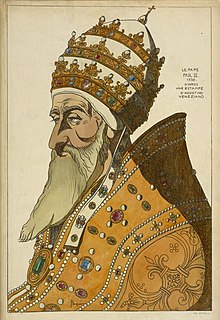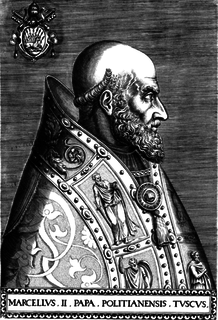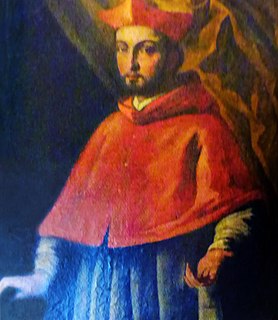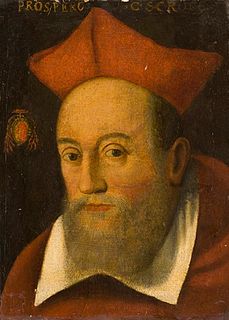This article relies largely or entirely on a single source .(May 2017) |
Pietro Isvalies (died 1511) (called the Cardinal of Oristano) was an Italian Roman Catholic bishop and cardinal.
This article relies largely or entirely on a single source .(May 2017) |
Pietro Isvalies (died 1511) (called the Cardinal of Oristano) was an Italian Roman Catholic bishop and cardinal.
Pietro Isvalies was born in Messina, part of an obscure family of Spanish origin. [1]
Early in his career, he became a canon of the cathedral chapter of the Cathedral of Messina. [1] He later became vicar general of the metropolitan see of Messina. [1] He later moved to Rome, becoming a protonotary apostolic. [1] He was the governor of Rome from August 11, 1496 until September 1500. [1]
On February 18, 1497, he was elected Archbishop of Reggio Calabria. [1] He was consecrated as a bishop in the Sistine Chapel on June 4, 1497 by Bartolomé Flores, Archbishop of Cosenza, secretary to the pope. [1] [2] He occupied this post until July 24, 1506, when he resigned in favor of his nephew Francesco. [1]
At the request of Ferdinand II of Aragon, Pope Alexander VI made Isvalies a cardinal priest in the consistory of September 28, 1500. [1] He received the red hat on October 2, 1500 and the titular church of San Ciriaco alle Terme Diocleziane on October 5, 1500. [1]
On October 5, 1500, he was made legate a latere to the Kingdom of Hungary and the Kingdom of Poland; he left for the legation on November 19, 1500. [1]
On June 21, 1503, he became the apostolic administrator of the see of Veszprém, occupying this post until his death. [1]
He did not participate in the papal conclave of September 1503 that elected Pope Pius III. [1] He did participate in the papal conclave of October 1503 that elected Pope Julius II. [1]
He opted for the titular church of Santa Pudenziana on August 18, 1507, though he retained the titulus of San Ciriaco alle Terme Diocleziane in commendam until his death. [1] He was the administrator of the see of Ourense from June 7, 1508 until his death. [1] He was the cardinal protector of the Kingdom of Poland from May 1, 1510. [1] He was the administrator of the see of Messina from 1510 until his death. [1]
In January 1511, he accompanied the pope to the siege of Mirandola. [1] In Ravenna on May 24, 1511, the pope made him legate a latere to Bologna and Romagna. [1] He was archpriest of the Basilica di Santa Maria Maggiore. [1]
He died in Cesena on September 22, 1511. [1] He is buried in the Basilica di Santa Maria Maggiore. [1]

The 1534 papal conclave was convened after the death of Pope Clement VII, and elected as his successor cardinal Alessandro Farnese, who became Pope Paul III.

The April 1555 papal conclave was convoked after the death of Pope Julius III. Elected as his successor Cardinal Marcello Cervini, who took the name of Marcellus II, being the last pope who retained his baptismal name.

Juan de Borja Lanzol (Llançol) de Romaní, el mayor was the first of ten cardinal-nephews elevated by Pope Alexander VI, the cousin of his father, Galcerán de Borja y Moncada.
San Ciriaco alle Terme Diocleziane was a church in the Baths of Diocletian in Rome. It was made a titulus by the Roman synod of 1 March 499. According to a list written by Pietro Mallio during the pontificate of pope Alexander III, it was linked to the basilica church of Santa Maria Maggiore and its priests celebrated mass alternately at the two churches. In the 12th century it was known as San Ciriaco in thermis and, under pope John XXII, as San Ciriaco in Verminis. The titulus was suppressed by Pope Sixtus V, who replaced it with that of Santi Quirico e Giulitta.
Juan de Borja Lanzol de Romaní the Younger (1470–1500) was a Spanish Roman Catholic bishop and cardinal.

Giambattista Orsini was an Italian Roman Catholic cardinal. He served as papal legate to the Marches of Ancona.
Federico di Sanseverino was an Italian Roman Catholic cardinal of the 16th century.

Bernardino Lunati (1452–1497) was an Italian Roman Catholic cardinal.

Luigi d'Aragona (1474–1519) was an Italian Roman Catholic cardinal. He had a highly successful career in the church, but his memory is affected by the allegation that he ordered the murder of his own sister and two of her children.
Amanieu d'Albret was a French Roman Catholic cardinal.

Marco Cornaro was an Italian Roman Catholic cardinal and bishop.

Francisco de Remolins (1462–1518) was a Spanish Roman Catholic bishop and cardinal.

Robert Guibé was a French Roman Catholic bishop and cardinal.

Leonardo Grosso della Rovere was an Italian Roman Catholic bishop and cardinal.
Bonifacio Ferrero (1476–1543) was an Italian Roman Catholic bishop and cardinal.

Marcello Crescenzi was an Italian Roman Catholic bishop and cardinal.
Girolamo Verallo (1497–1555) was an Italian Roman Catholic bishop and cardinal.
Giovanni Andrea Mercurio (1518–1561) was an Italian Roman Catholic bishop and cardinal.

Prospero Pubblicola Santacroce was an Italian Roman Catholic bishop and cardinal.
Alessandro Sforza (1534–1581) was an Italian Roman Catholic bishop and cardinal.